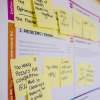What is the role of a product designer?
- Spotting opportunities for a new product
- Understanding the customer and business needs
- Translating user requirements into a design
- Solving problems by understanding UI (User Interface), UX (User Experience) and design systems. Design systems are libraries of design components and patterns.
They can be involved in the end-to-end product process, from product development strategy to getting the product into the market, working closely with developers, engineers, other designers, and marketers. And they are different from industrial designers, who deal with physical products.
As a career, I would say product designers are one of the most in-demand professionals, especially one with cross-functional skills such as front-end coding and marketing experience. With more and more physical products having a digital component, I think this role will only grow in the future.
What is the difference between product designers and UX designers?
- Is the product a right fit for the current economy?
- Does this product align with the business goals?
- How can I make the design cost-effective, consistent, flexible, or scalable?
- Is the product easy to use?
-
How can I make the design more user-friendly?
What does a product designer do daily?
1. Research market trends and user requirements
2. Create and understand user personas and user journey maps
User persona and user journey maps are important ingredients for generating ideas. By understanding who the users are, what they need, and what the buying experience looks like, you are in a better position to design solutions that actually matter to your users.
3. Outline the product design
4. Design the prototype or product
5. Conduct user testing and interviews
6. Develop design systems
7. Collaborate with different teams
8. Get buy-ins for their product
Depending on the size of the company, a product designer may have an added responsibility of convincing stakeholders and investors to bank on a product or feature. They use tools like prototypes, user research and market data to get management buy-ins.
What skills does a product designer need?
- design thinking principles
- product and project management
- product design for desktop and mobile devices
- prototyping skills
- user research skills
Many product designers come from different backgrounds such as graphic design, marketing, sales, and UX research. This is because a product designer doesn’t just design but needs to have enough business acumen and the skills to discover what the user wants in a product. You can acquire these skills from other jobs, and when you’re ready to make the leap to a product designer, it can be an exciting career.







